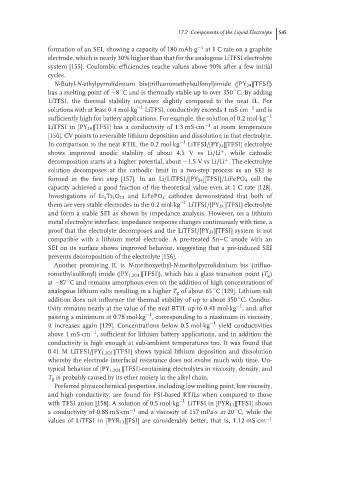Page 571 - Handbook of Battery Materials
P. 571
17.2 Components of the Liquid Electrolyte 545
formation of an SEI, showing a capacity of 180 mAh·g −1 at 1 C rate on a graphite
electrode, which is nearly 30% higher than that for the analogous LiTFSI electrolyte
system [155]. Coulombic efficiencies reache values above 90% after a few initial
cycles.
N-Butyl-N-ethylpyrrolidinium bis(trifluoromethylsulfonyl)imide ([PY 24 ][TFSI])
◦
has a melting point of −8 C and is thermally stable up to over 350 C. By adding
◦
LiTFSI, the thermal stability increases slightly compared to the neat IL. For
−1 −1
solutions with at least 0.4 mol·kg LiTFSI, conductivity exceeds 1 mS·cm and is
sufficiently high for battery applications. For example, the solution of 0.2 mol·kg −1
LiTFSI in [PY 24 ][TFSI] has a conductivity of 1.3mS·cm −1 at room temperature
[156]. CV points to reversible lithium deposition and dissolution in that electrolyte.
−1
In comparison to the neat RTIL, the 0.2 mol·kg LiTFSI/[PY 24 ][TFSI] electrolyte
shows improved anodic stability of about 4.5 V vs Li/Li , while cathodic
+
+
decomposition starts at a higher potential, about −1.5 V vs Li/Li . The electrolyte
solution decomposes at the cathodic limit in a two-step process as an SEI is
formed in the first step [157]. In an Li/LiTFSI/[PY 24 ][TFSI]/LiFePO 4 cell the
capacity achieved a good fraction of the theoretical value even at 1 C rate [128].
Investigations of Li 4 Ti 5 O 12 and LiFePO 4 cathodes demonstrated that both of
them are very stable electrodes in the 0.2 mol·kg −1 LiTFSI/[PY 24 ][TFSI] electrolyte
and form a stable SEI as shown by impedance analysis. However, on a lithium
metal electrolyte interface, impedance response changes continuously with time, a
proof that the electrolyte decomposes and the LiTFSI/[PY 24 ][TFSI] system is not
compatible with a lithium metal electrode. A pre-treated Sn–C anode with an
SEI on its surface shows improved behavior, suggesting that a pre-induced SEI
prevents decomposition of the electrolyte [156].
Another promising IL is N-methoxyethyl-N-methylpyrrolidinium bis (trifluo-
romethylsulfonyl) imide ([PY 1.2O1 ][TFSI]), which has a glass transition point (T g )
◦
at −87 C and remains amorphous even on the addition of high concentrations of
analogous lithium salts resulting in a higher T g of about 65 C [129]. Lithium salt
◦
◦
addition does not influence the thermal stability of up to about 350 C. Conduc-
−1
tivity remains nearly at the value of the neat RTIL up to 0.41 mol·kg ,and,after
−1
passing a minimum at 0.78 mol·kg , corresponding to a maximum in viscosity,
it increases again [129]. Concentrations below 0.5 mol·kg −1 yield conductivities
−1
above 1 mS·cm , sufficient for lithium battery applications, and in addition the
conductivity is high enough at sub-ambient temperatures too. It was found that
0.41 M LiTFSI/[PY 1.2O1 ][TFSI] shows typical lithium deposition and dissolution
whereby the electrode interfacial resistance does not evolve much with time. Un-
typical behavior of [PY 1.2O1 ][TFSI]-containing electrolytes in viscosity, density, and
T g is probably caused by its ether moiety in the alkyl chain.
Preferred physicochemical properties, including low melting point, low viscosity,
and high conductivity, are found for FSI-based RTILs when compared to those
with TFSI anion [158]. A solution of 0.5 mol·kg −1 LiTFSI in [PYR 13 ][TFSI] shows
a conductivity of 0.88 mS·cm −1 and a viscosity of 157 mPa·sat20 C, while the
◦
values of LiTFSI in [PYR 13 ][FSI] are considerably better, that is, 1.12 mS·cm −1

